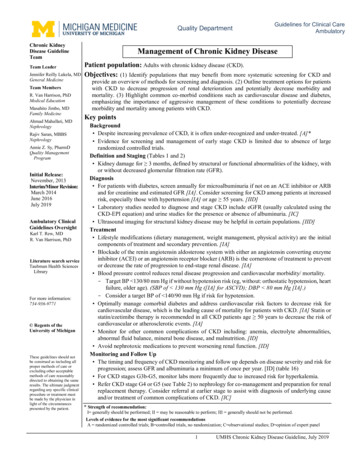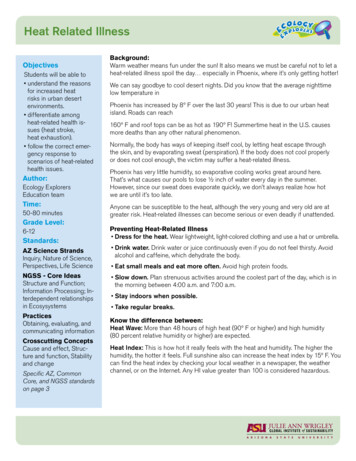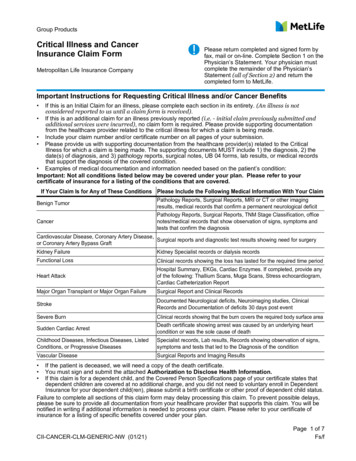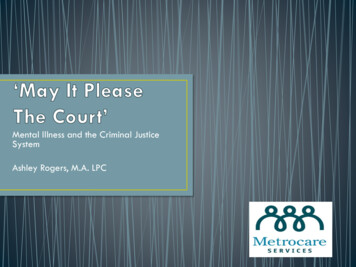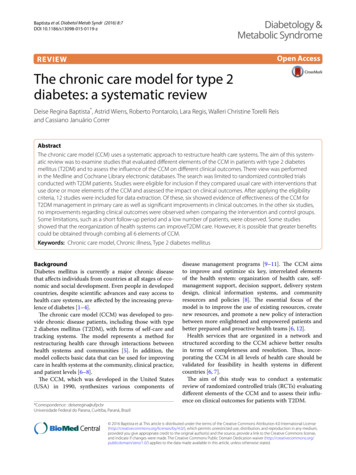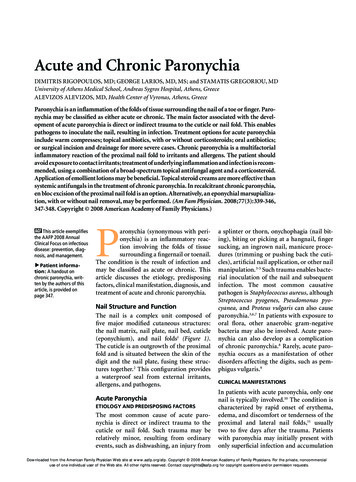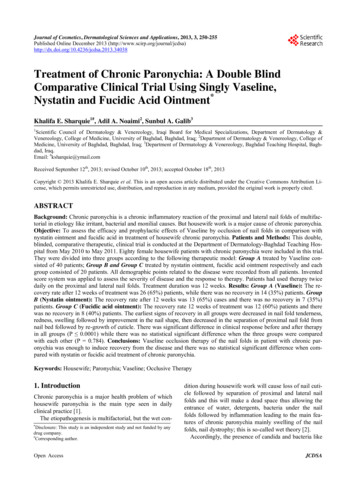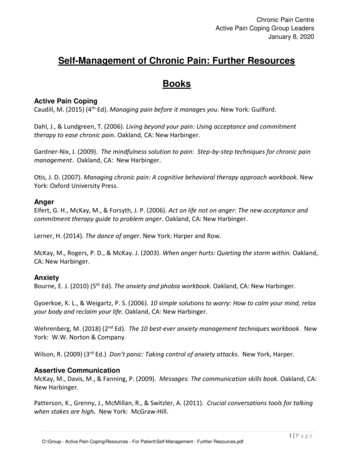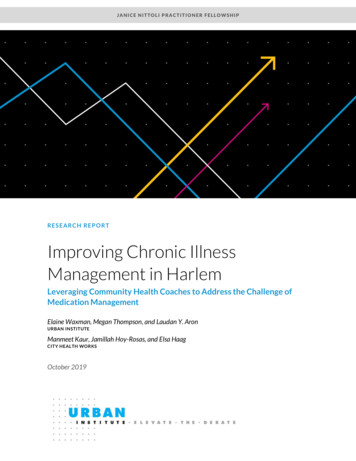
Transcription
JANICE NITTOLI PRACTITION ER FELLOWSHIPRE S E AR CH RE P O R TImproving Chronic IllnessManagement in HarlemLeveraging Community Health Coaches to Address the Challenge ofMedication ManagementElaine Waxman, Megan Thompson, and Laudan Y. AronURBAN INSTITUTEManmeet Kaur, Jamillah Hoy-Rosas, and Elsa HaagCITY HEALTH WORKSOctober 2019
AB O U T T HE U R BA N I NS T I T U TEThe nonprofit Urban Institute is a leading research organization dedicated to developing evidence-based insightsthat improve people’s lives and strengthen communities. For 50 years, Urban has been the trusted source forrigorous analysis of complex social and economic issues; strategic advice to policymakers, philanthropists, andpractitioners; and new, promising ideas that expand opportunities for all. Our work inspires effective decisions thatadvance fairness and enhance the well-being of people and places.Copyright October 2019. Urban Institute. Permission is granted for reproduction of this file, with attribution to theUrban Institute. Cover image by Tim Meko.
ContentsAcknowledgmentsivImproving Chronic Illness Management in Harlem1Introduction1Chronic Disease in the United States1Effective Chronic Care Delivery2The Reality of Care Delivery and Medication Management3Effective Medication Management Strategies5Health Coaching As a Patient-Centered Intervention7Leveraging Community Support: The City Health Works Model8Client Characteristics, Challenges, and Escalations9Medication-Related Escalations10Material Hardship and Medication Management16Implications for Policy and Practice17Insights for the FieldConclusion1821Notes22References23About the Authors26Statement of Independence29
AcknowledgmentsThis report was funded by the Rockefeller Foundation through the Janice Nittoli PractitionerFellowship. We are grateful to them and to all our funders, who make it possible for Urban to advanceits mission.The views expressed are those of the authors and should not be attributed to the Urban Institute,its trustees, or its funders. Funders do not determine research findings or the insights andrecommendations of Urban experts. Further information on the Urban Institute’s funding principles isavailable at urban.org/fundingprinciples.We dedicate this report to the committed, hardworking community health workers across theglobe, who play a vital role in bolstering the health of their communities and preventing crises. Oneconversation at a time, they enable their neighbors to feel more empowered and less alone when facedwith health challenges.ivACKNOWLEDGMENTS
Improving Chronic IllnessManagement in HarlemIntroductionSince 2012, City Health Works in Harlem, New York, has hired clinically supervised, neighborhoodbased health coaches to support low-income patients with chronic illnesses, helping them develop theknowledge, capabilities, and confidence to better manage their health. Medication management is amajor focus in these coaches’ interactions with clients. Coaches frequently find discrepancies betweenthe medications doctors prescribe and the medications present in the home. Additional complicationsarise from expired medications, nonprescription medications, patient misconceptions aboutmedications, and challenges such as low literacy levels, poor eyesight, and food insecurity. As of March2018, City Health Works coaches had worked with 776 clients, escalating 246 medical issues for 146patients, including 122 urgent medication needs for 91 patients, potentially diverting costly trips tohospital emergency rooms. The often tangled interactions between health care providers, pharmacies,and patients can precipitate medication errors and escalations; preventing and mitigating theseincidences are major benefits of community-based coaching programs like City Health Works.This report investigates a key component of City Health Works' health coaching: medicationmanagement. Drawing on City Health Works’ administrative data, we present the major reasons formedication issues, including those that required escalations to clinical supervisors or providers, as wellas other actions and resolutions. We also discuss how community-based coaching can act as anextension of primary care by addressing medication management or adherence challenges that emergein patients’ daily lives and are difficult to resolve through traditional primary care or pharmacy visitsand how health coaching can develop patients' self-management skills, including medication adherence.We conclude with some insights for the chronic care management field, particularly around medicationmanagement, based on City Health Works’ experiences.Chronic Disease in the United StatesEighty-six percent of the nation's 2.7 trillion annual health expenditures are for people with chronicconditions (Gerteis et al. 2014). These expenses are primarily for physical or mental health conditionslasting more than one year and often resulting in functional limitations and requiring ongoing
monitoring and treatment. Sixty percent of American adults have at least one chronic condition, and 42percent have multiple chronic conditions (Buttorff, Ruder, and Bauman 2017). Many of the mostcommon chronic diseases and conditions, including obesity, type 2 diabetes, and heart disease, areamong the most costly and preventable health conditions. Preventing or managing these conditions,however, requires careful attention to diet, medication, and social determinants of health, such asstable housing, food security, access to transportation, and economic security.How patients take medications and how they manage those medications alongside socialdeterminants of health are major elements of chronic disease care and management. The share of USadults taking medications has steadily risen over the last several decades: about half (47 percent) of USadults take at least one prescription drug and about a quarter (22 percent) take three or more (NationalCenter for Health Statistics 2017). For people over age 65, 77 percent of prescriptions are taken yearround for chronic conditions, and though people ages 50 and over represent about a third of the USpopulation, they account for 70 percent of all prescriptions (IQVIA Institute for Human Data Science2017).Nationally, about one in five prescriptions is never filled (Osterberg and Blaschke 2005). Whenprescriptions are filled, medication adherence—taking medications at the recommended time, dosage,frequency, or over the recommended duration—is an ongoing challenge for patients living with chronicconditions, as well as their providers.1 Nonadherence to medication regimens is associated with higherrates of hospital admissions, increased morbidity and mortality, suboptimal health outcomes, andincreased health care costs, estimated at an extra 100–300 billion each year (DiMatteo 2004; Iuga andMcGuire 2014; Viswanathan et al. 2012).Effective Chronic Care DeliveryThe current US health care system was built around treating acute illness rather than chronicconditions. Thus, building effective chronic care delivery requires restructuring the system andstrengthening the relationship between patients and the health system to better support patients incontinuously managing their condition(s).The Chronic Care Model, first advocated for by Edward Wagner as a multipronged strategy forimproving care for patients living with chronic illness, argues that for the patient-provider relationshipto be productive and improve outcomes, health systems must reconfigure ambulatory care systems toaddress chronically ill patients’ ongoing needs and concerns (Coleman et al. 2009; Wagner 1998). Themodel emphasizes the following:2IMPROVING CHRONIC IL LNESS MANAGEMENT IN HARLEM
Fostering planned, team-oriented care delivery, particularly among primary care teamsincreasingly occupied with caring for older, chronically ill patients. Educating and empowering patients living with chronic disease to serve as their “self-manager”at home, bolstered by community supports.2 Building provider skill and expertise, including implementing evidence-based guidelines forchronic care management. Enhancing clinical information systems to facilitate coordinated, consolidated communicationamong care team members and across patient encounters (e.g., between inpatient care anddifferent ambulatory settings).The Chronic Care Model has been widely adopted for improving care delivery and has beenintegrated into current concepts of a patient-centered medical home. The model centers the primarycare provider as a care coordinator and prioritizes integrating services that may address a range ofpatient needs, such as pharmacy, patient education and coaching, specialty care, and behavioral healthservices. Integrated care delivery reduces the patient’s onus to manage disconnected outpatient,inpatient, pharmacy, and other care management interactions and facilitates a more intentional focuson building patient self-management capacity and creating an informed and activated patient. Andbecause a patients’ self-management of their condition(s) leads to better outcomes, health care systemsare being challenged to better support patients outside the clinical setting.The Reality of Care Delivery andMedication ManagementHealth systems across the country continue to grapple with better ways to deliver quality and costeffective care to patients with chronic illness. Medication is often an important strategy for treatingchronic illness, but some estimate that at least half of patients with chronic health conditions haveinadequate medication management (Brown and Bussell 2011; Lin et al. 2010). This largely owes to thefragmented health care environment. For patients with multiple conditions and medications, thenumber and type of medical providers often increases, increasing the risk of miscommunication anderrors (Buttorff, Ruder, and Bauman 2017). This risk can be particularly acute in large urbanenvironments (Cancino 2017); some providers’ large volume of patients can reduce their ability toadequately support patients, even in team-oriented environments (Altschuler et al. 2019).IMPROVING CHRONIC ILLNESS MANAGEMENT IN HARLEM3
Poor medication management and medication errors can have life-threatening consequences.3Adverse drug events account for nearly 700,000 emergency department visits and 100,000hospitalizations per year.4 One study of 661 patients in outpatient care revealed that 25 percentexperienced adverse drug events; 13 percent were serious, 28 percent ameliorable, and 11 percentpreventable. Of ameliorable events (ones that were deemed not preventable but where the severity ofthe problem could have been reduced with different actions), 63 percent related to a physician’s failureto respond to a medication-related symptom, and 37 percent related to the patient’s failure to informthe physician of symptoms (Gandhi et al. 2003).Various factors contribute to medication errors, problems with medication adherence, and adversedrug events (table 1). These include poor communication between multiple providers, clinics, andpharmacies; insurance errors; and patient factors such as knowledge, memory, and cognitiveimpairment (Allen et al. 2016; Gellad, Grenard, and Marcum 2011).TABLE 1Health System and Patient Factors That Contribute to Medication Errors and NonadherenceHealth system Patient Refill never submitted to pharmacy or given to patientWrong dose or device prescribedPoor relationship with patient/misunderstanding of patient’s socioeconomicenvironmentLack of knowledge about patient’s condition(s)Prescription for paired medications/devices lackingManaging multiple medication regimens simultaneouslyManaging multiple complex conditions simultaneouslyPharmacy errorsInsurance issuesLack of cultural competence among providersRacial/ethnic disparities in access to careKnowledge and understanding of condition(s)Health literacyForgetfulnessMedication delivery device confusionUncertainty over adherence instructionsRefill process confusionInsurance issuesManaging multiple medication regimens simultaneouslyManaging multiple complex conditions simultaneouslySources: City Health Works escalation data; Allen et al. (2016); and Gellad, Grenard, and Marcum (2011).Note: Health systems include physicians, pharmacies, clinicians, or insurance.Medication management for patients living with multiple chronic conditions and socioeconomicstressors is particularly challenging: many patients require multiple medications and medicationdelivery devices and must navigate a complex system of providers, pharmacies, and insurancecompanies. In vulnerable populations, medication adherence rates tend to be lower than in other4IMPROVING CHRONIC IL LNESS MANAGEMENT IN HARLEM
groups because of social determinants of health such as economic insecurity, low literacy levels, limitedEnglish proficiency, poor mental health, cost barriers, and comorbidity (Aspden et al. 2007). Advancedage and certain illnesses that cause cognitive impairment or forgetfulness may also increase thelikelihood of medication adherence issues.Though clinical settings (Barker et al. 2002; Brady, Malone, and Fleming 2009; He et al. 2017),including pharmacies (Friedman et al. 2007; Murray et al. 2009), are making greater attempts toimprove medication management, much work remains. Some have called for "correct medication lists,"which would require reconciling medications for patients seeing multiple clinicians, deprescribingmedications when they are no longer needed or appropriate, and coordinating with outside entitiessuch as pharmacies and electronic medical records companies (Rose, Fischer, and Paasche-Orlow2017). However, the health care system’s systemic limitations, such as fragmentation of services, limitedcommunication among service providers, and little time devoted to patient education and support,contribute to poor medication oversight and management.Many patients, especially those managing multiple chronic condi
This report was funded by the Rockefeller Foundation through the Janice Nittoli Practitioner Fellowship. We are grateful to them and to all our funders, who make it
